Hi all
We are thinking of putting in some recessed lights in our kitchen. The wiring is already there because the previous owner had some kitchen cupboards on the wall (we have now removed them) and there were lights beneath the cupboard.
But the thing is, we would rather not disturb the carpets etc upstairs as they were laid not too long ago.
So would it be possible to fit the recessed spot lights (or for that matter ANY lighting, as we are not dead set on the recessed option) from the kitchen itself? We are doing work in the kitchen, so mess etc would not be a problem.
Any advice would be most helpful
Cheers
Max
We are thinking of putting in some recessed lights in our kitchen. The wiring is already there because the previous owner had some kitchen cupboards on the wall (we have now removed them) and there were lights beneath the cupboard.
But the thing is, we would rather not disturb the carpets etc upstairs as they were laid not too long ago.
So would it be possible to fit the recessed spot lights (or for that matter ANY lighting, as we are not dead set on the recessed option) from the kitchen itself? We are doing work in the kitchen, so mess etc would not be a problem.
Any advice would be most helpful
Cheers
Max





